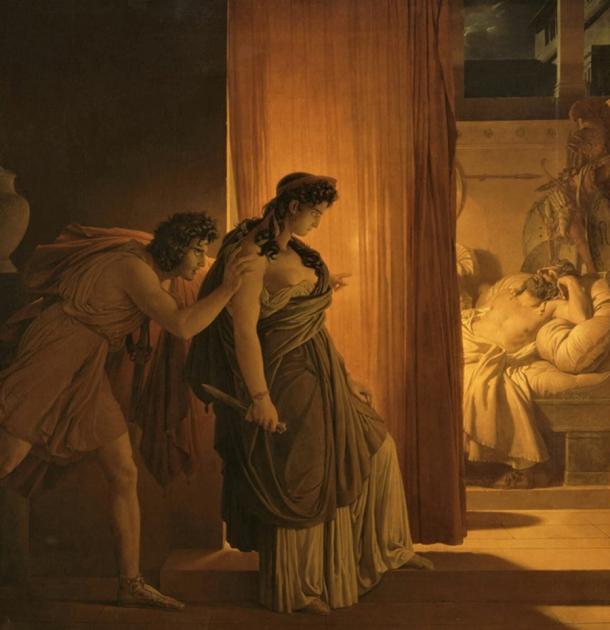The Red Carpet Treatment Goes Back Over 2,000 Years
Today, the red carpet is associated with VIPs, dignitaries, the heads of state, celebrities, film festivals. It conjures up images of flashing of camera lights and paparazzi, glitzy gowns and make-up, elaborate suits and attire, important dignitaries landing in large airplanes and waving to crowds. This is a very modern conception of what the red carpet has come to symbolize. What is lesser known is that the red carpet’s first mention in popular culture actually goes back to ancient Greece, over 2,000 years ago.

In Agamemnon (the first play of three in the Oresteia), King Agamemnon is persuaded to walk along a red carpet into his palace. (JamesMacMillan / CC BY-SA 4.0)
Aeschylus’ Agamemnon – Mortality and Divinity
More specifically, this reference is first found 2,500 years ago in a Greek epic credited to the father of tragedy, Aeschylus and his story of Agamemnon, the first of three plays that combine to create the Oresteia. In this epic from 458 BC, King Agamemnon’s vengeful Queen Clytemnestra prepares for the grand return of her husband from a victory in the Trojan War. Clytemnestra speaks of a “floor of crimson broideries to spread / For the King's path.”
This remains not just the first mention of the crimson carpet, but also the first suggestion of a difference between people considered as “mortal” and those to be placed on a pedestal. Even during the story, Aeschylus’ protagonist responds by saying, “I am a mortal, a man; I cannot trample upon these tinted splendors without fear thrown in my path.”
It is important to note that Clytemnestra sought vengeance against her husband for two reasons – firstly, because he was coming back with his newest concubine Cassandra, and secondly, because of Agamemnon’s role in the death of their daughter, Iphigenia, a decade earlier.
“Agamemnon goes away to fight (in the Trojan Wars) and leaves his wife Clytemnestra at home,” explained Amy Henderson, historian emeritus at the National Portrait Gallery in Washington, in a 2019 CNN report. “He's away for a long time, and they both find significant others. When he comes back, he's in love with Cassandra and brings his concubine home with him.”
Agamemnon was right to be cautious, though he would end up relenting and walking on the vermilion carpet, albeit without his sandals. The carpet would lead him into his palace, where he would eventually end up being stabbed to death in his bathtub by Clytemnestra. Talk about premonitions! “She rolls out the crimson carpet to convince him to walk into his death,” added Henderson. Accounts differ, but Clytemnestra either murdered Agamemnon in the bath, or he was slain by her lover. She also kills Cassandra. “It's not a pretty story.”
Scholars like Jeanne Gutierrez, a senior fellow in women’s history at the New York Historical Society, said that the association with the color red in ancient Greece was of divinity and the gods. “He was hesitant to step upon it because red in ancient Greece was considered a divine color,” Gutierrez told TIME in 2019. Perhaps the shade itself was more important than the red carpet.

Clytemnestra hesitates before killing the sleeping Agamemnon, by Pierre-Narcisse Guérin. (Public domain)
The Renaissance and the Industrial Revolution
Oddly enough, there are very, very few recorded instances of the red carpet and its usage in history after this point, right up till modern history. There are a few unverified and isolated instances of the red carpet being used by the elite in the Renaissance (roughly between the 14th and 16th centuries) in western Europe. At the same time, there isn’t enough corroborating historiography that points to the usage as a symbol of power or status.
In Renaissance art itself, the usage of red carpets and rugs was frequent, Oriental in origin, with intricate patterns. They typically appeared in paintings of deities, saints, and royalty, which according to certain historians, is due to the preciousness of the scarlet dye. The dye was the most difficult to make and the most expensive – taken from the cochineal scale insect found in the Americas. In fact, the Aztecs and Mayas frequently used this dye and technique to color fabrics.
It would become a popular and highly valued export by the 17th century. The price of red dye began decreasing in the 16th century after Spain’s conquest of Latin America. As they did with coffee, tobacco, and several other commodities, the Spanish took over and made it a lucrative trade. This prompted other western European colonial competitors to enter the market, who began producing female cochineal insects to sell the dye.
However, the Industrial Revolution would make the dye ubiquitously available, with synthetic dye available by the end of the 1700s. What was associated with the elite was now available in a in mass quantity for the poorer sections of western society.

Red carpet for the premiere of Robin Hood at the Egyptian Theatre in California, 1922. (Public domain)
Modern Day Glitz and Glam: The Red Carpet Tradition
In the period after the export of the scarlet, cochineal dye became popular, a symbolism with royalty and the elite continued to be of a high status. The next popularly recorded instance of the red carpet would occur in the early 19th century in the United States. In 1821, a new association with the red carpet and transport came to be, when James Monroe, the fifth president of the USA, stepped off a riverboat in South Carolina as a show of ceremony. Right from Prospect Hill (today called Arcadia), a red carpet was laid out to the river.
The contemporary association begins just a little over a century ago, and it too is related to transport and social status. This was the iconic 20th century Limited Express on the New York Central Railroad, running from 1902 to 1967 taking people from New York to Chicago much faster than ever before. A red carpet was rolled out in Grand Central Station for the people making their way into the train, leading to the beginning of the so-called red-carpet treatment.
In 1922, the concept travelled west for the premiere of Robin Hood at the Egyptian Theatre in California, the first (and now century-long) association with Hollywood. It would be graced by the first king of Hollywood, Douglas Fairbanks, as he arrived for the premiere. The Academy Awards in 1961 would adopt the tradition and broadcast it on TV. However, the final piece in the puzzle was in 1964, when both the ceremony and the tradition were broadcast on color television, making it a mass phenomenon.
- A Brief History of the Enduring Iconic Female Phenomenon of Red Lipstick
- Ancient Peruvian Gold Mask Was Painted with Human Blood!
It was only in the 1990s that the idea of fusing Hollywood and fashion became a synonymous concept. This era gave birth to celebrity designers and make-up artists, particularly for women, subject to the intense scrutiny of the unforgiving public glare. Body types, make-up styles, hairstyles, and fabric, right down to footwear, worn on the red carpet, became a part of mass public consciousness and taste.
“It’s interesting that the red carpet has become synonymous with movie stars who in a sense have become the royalty of today,” Sonnet Stanfill, senior curator at the Victoria & Albert Museum, told BBC Culture in 2016. “The evolution of the picture house in the second half of the 20th century made them the palaces of the people. There’s a certain synergy about the red carpet – that was traditionally to welcome royalty – now welcoming film royalty,” he concluded.
Top image: Celebrity on a red carpet. Source: Tom Merton/KOTO / Adobe Stock
By Sahir Pandey
References
Avila, M. 2010. “When did the red carpet tradition begin?” in LiveScience. Available at: https://www.livescience.com/32522-when-did-the-red-carpet-tradition-begin.html
Baker, L. 2016. “Where does the red carpet from?” in BBC Culture. Available at: https://www.bbc.com/culture/article/20160222-where-does-the-red-carpet-come-from
Datta, P.K. 2018. “What is red carpet welcome and where did it come from?” in India Today. Available at: https://www.indiatoday.in/india/story/what-is-red-carpet-welcome-and-where-did-it-come-from-1391949-2018-11-19
Greenspan, R. E. 2019. “Why Does Hollywood Roll Out a Red Carpet? Here’s How the Oscars Tradition Began” in TIME. Available at: https://time.com/5533549/history-red-carpet-hollywood/
Melissa. 2016. “Who started the red carpet tradition?” in Today I Found Out. Available at: http://www.todayifoundout.com/index.php/2016/02/leading-powerful-wealthy-famous-just-rewards-origin-red-carpet-treatment/
Miller, J. 2014. “The Evolution of Hollywood’s Red Carpet, from the Golden Age to the GlamCam360” in Vanity Fair. Available at: https://www.vanityfair.com/hollywood/2014/08/red-carpet-history
Page, T. 2019. “Greek tragedy and railways: An unexpected history of the red carpet” in CNN Style. Available at: https://edition.cnn.com/style/article/an-unexpected-history-of-the-red-carpet/index.html



















